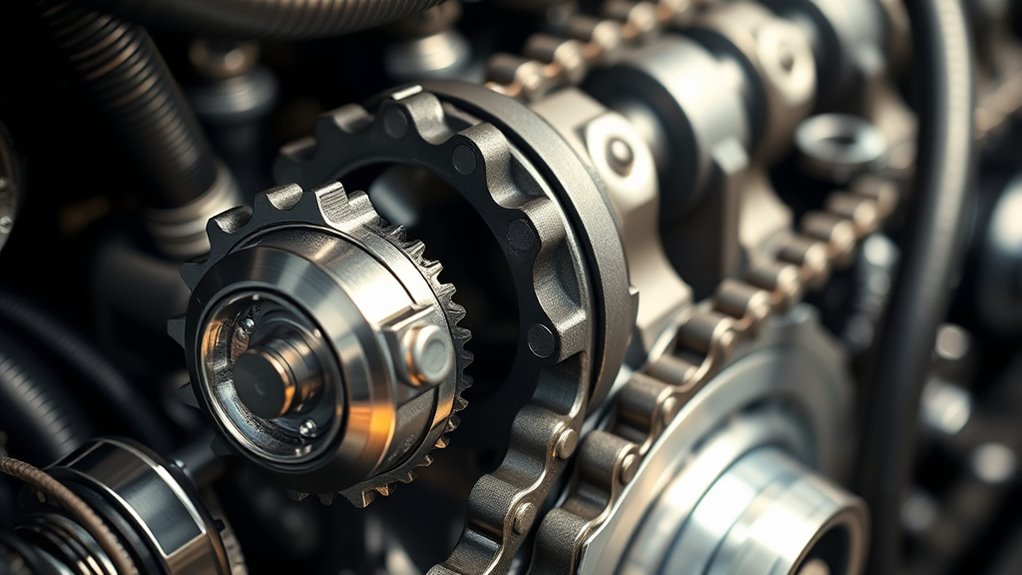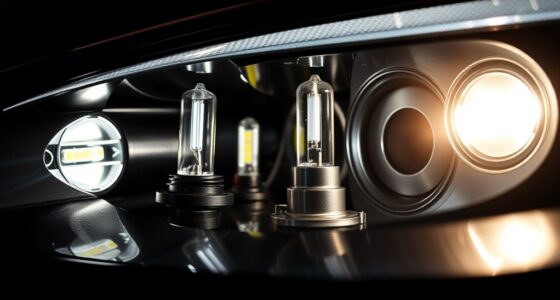The Ford Transit uses either a timing chain or a timing belt, depending on the engine model. Older 2.2L and 2.4L TDCi diesel engines typically have durable timing chains that rarely need replacement, often lasting beyond 300,000 miles. Newer EcoBlue engines, like the 1.6L and 2.0L, use wet belts that require scheduled changes around every 6 years or 100,000 miles. Understanding your engine’s system helps guarantee proper maintenance—learn more to keep your transit running smoothly.
Key Takeaways
- 2.2L & 2.4L TDCi diesel engines typically use durable timing chains inside metal covers.
- EcoBlue diesel engines (post-2016) generally employ lubricated wet belts requiring scheduled replacements.
- Older petrol and diesel Ford Transits often feature traditional dry timing belts that need regular replacement.
- Timing chains last longer, often over 200,000 miles, and require less maintenance compared to wet belts.
- Visual inspection and signs like engine noise or performance issues help determine if a belt or chain needs replacement.
Overview of Ford Transit Engine Timing Systems

The Ford Transit employs different timing systems depending on the engine model and year, which influences maintenance and repair procedures. Some engines use timing chains, like the 2.2L TDCi diesel from around 2006 onward, known for durability and requiring less frequent replacement. Others, especially newer models with 1.5L and 2.0L EcoBlue diesel engines produced after 2016, utilize wet belt systems that run inside the engine and are lubricated by oil. Traditional dry timing belts are found in older petrol and diesel engines. Each system has unique mechanical features and maintenance needs. Timing chains generally need minimal upkeep, while wet belts require strict oil changes and inspections. The choice of timing system can affect the overall maintenance schedule and cost. Knowing your engine’s timing system helps you plan proper maintenance and avoid costly repairs. Additionally, understanding the engine’s design can help determine the most suitable replacement intervals and tools required for service. Being aware of the timing component type used in your engine can also influence the availability of replacement parts and service procedures. Recognizing the differences between timing chains and belts can further assist in making informed maintenance decisions.
Identifying the Timing System in Your Ford Transit
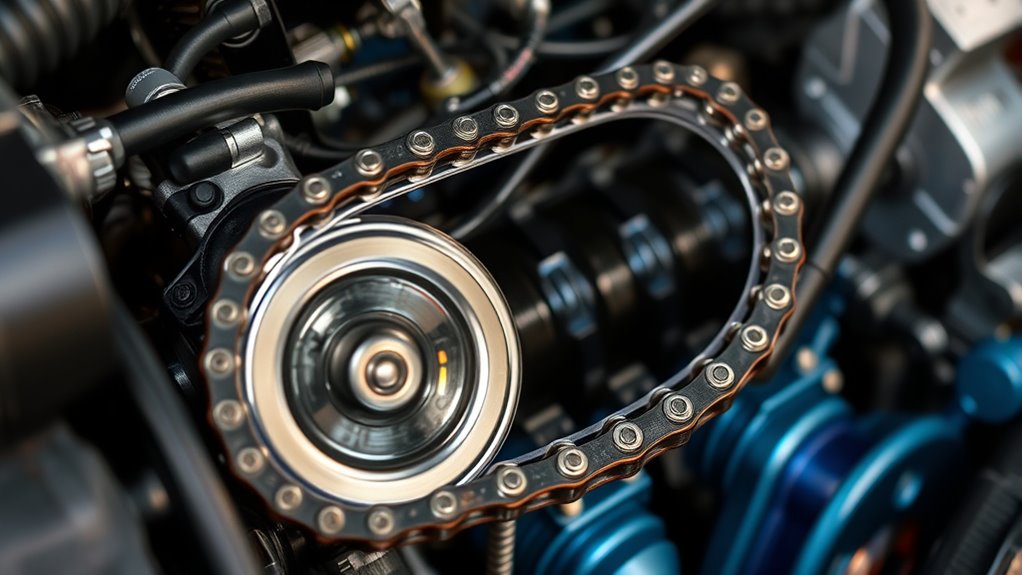
Determining whether your Ford Transit uses a timing chain or belt is essential for proper maintenance. Start by checking your engine model—2.2L and 2.4L DuraTorque diesel engines use chains, while some Euro-spec EcoBlue 2.0L engines have wet belts lubricated by oil. V6 gas engines, like 3.5L and 3.7L, usually have chains hidden behind a front cover prone to leaks. Visual inspection helps: chains are inside metal covers, requiring removal to see; belts are behind plastic covers at the front, easier to inspect visually. Wet belts run inside the engine, inaccessible without disassembly, and are typically more durable due to engine oil lubrication. To better understand the timing system in your vehicle, consult your owner’s manual or a professional mechanic. Additionally, the engine design can influence whether a belt or chain is used, as manufacturers select systems based on durability and maintenance needs. Refer to your vehicle’s manual, engine code, or VIN to confirm the exact system, as it varies by engine generation and market.
1.6L and 2.0L EcoBlue Engines: Wet Belt Details
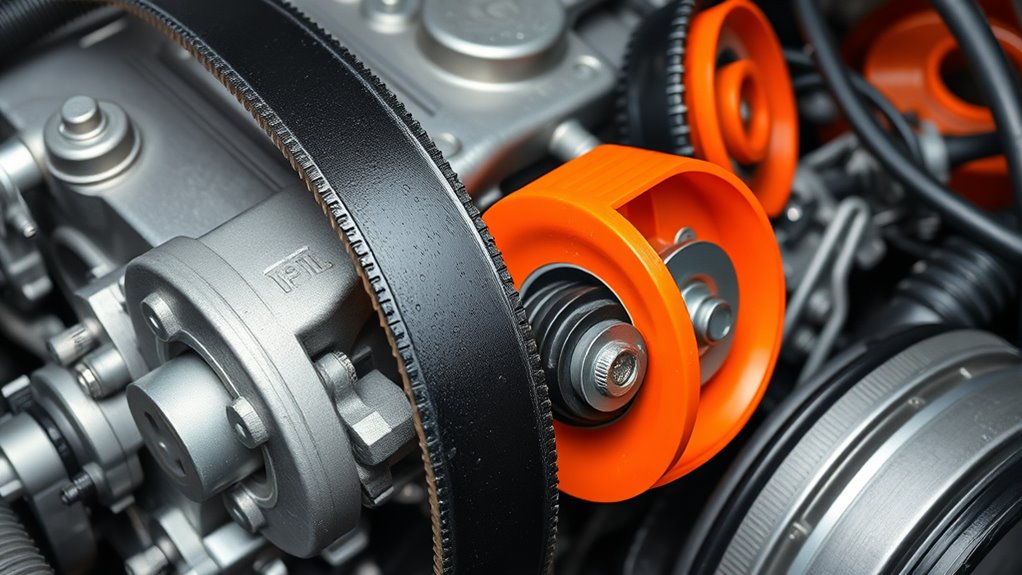
Maintaining the wet belt in your EcoBlue engine is vital, and Ford recommends replacing it every 6 years or 100,000 miles to prevent failure. Oil contamination can speed up wear, so using high-quality oil and staying on schedule is essential. Keep in mind, replacement costs can be significant due to the specialized parts and tools needed for proper installation. Revised service intervals now emphasize the importance of timely replacement to address issues caused by oil dilution and operational conditions. Additionally, selecting appropriate engine oils that meet manufacturer specifications can help extend the lifespan of the wet belt and improve overall engine health.
Wet Belt Maintenance Schedule
Regularly scheduled wet belt replacements are essential for ensuring the reliability of Ford Transit L and 2.0L EcoBlue engines. Ford recommends replacing the wet belt every 100,000 miles or 6-8 years, whichever comes first. While the original interval was up to 10 years or 150,000 miles, recent data prompted a shorter replacement schedule due to premature failures. Starting around 60,000 miles, inspect the belt for wear, especially if your vehicle is heavily used or part of a fleet. Since the belt operates in an oil bath, visual checks are limited, but signs of degradation or damage should prompt immediate replacement. Following the recommended schedule reduces risks of catastrophic engine damage caused by belt failure. Proper maintenance, including oil changes and belt inspections, is key to longevity. Additionally, understanding the engine-specific timing system can help in planning maintenance intervals more effectively. Staying informed about belt material properties can also aid in recognizing early signs of wear and potential failure. Regular inspections and monitoring operating conditions can further enhance belt longevity and performance.
Oil Contamination Risks
Because wet timing belts in Ford Transit 2.0L EcoBlue engines operate immersed in engine oil, contamination poses a significant risk to their longevity and performance. Oil contamination, especially from diesel ingress, can degrade the belt’s material, soften it, and accelerate wear. This increases the chance of fragments contaminating the oil, clogging strainers, and impairing oil circulation, which can lead to engine seizures. To prevent these issues, you should:
- Regularly check oil quality, including smell tests for diesel and debris in strainers.
- Monitor for sludge buildup on the belt surface.
- Schedule timely oil changes to minimize contamination and prolong belt life.
Contamination can also cause the belt to slip or lose tension, leading to timing issues that can affect engine operation. Additionally, understanding the engine design helps in identifying potential weak points where contamination might occur. Ignoring contamination signs can cause premature belt failure and costly engine damage, often without visible warning.
Replacement Cost Factors
Replacing the wet timing belt on a 2.0L EcoBlue engine involves several cost-influencing factors. The typical cost at independent shops is around £1,099, which covers parts like the belt, tensioner, water pump, oil pump belt, and sump pan. Using genuine Ford parts ensures reliability and warranty coverage but raises material costs. The engine’s design and component accessibility make the job labor-intensive, increasing overall expenses. Special tools, such as timing pins and crankshaft pullers, are necessary, adding to the complexity. The process includes removing auxiliary parts like the airbox, headlight, and power steering reservoir. Regional labor rates and whether you choose an independent or dealership shop also impact the final cost, with independents generally offering lower rates. Proper maintenance, including timing belt replacement, is essential for preventing costly engine damage and ensuring long-term reliability. Additionally, understanding the engine type can help anticipate the specific challenges and costs associated with the replacement process.
Older 2.2L and 2.4L TDCi Engines: Chain or Belt?
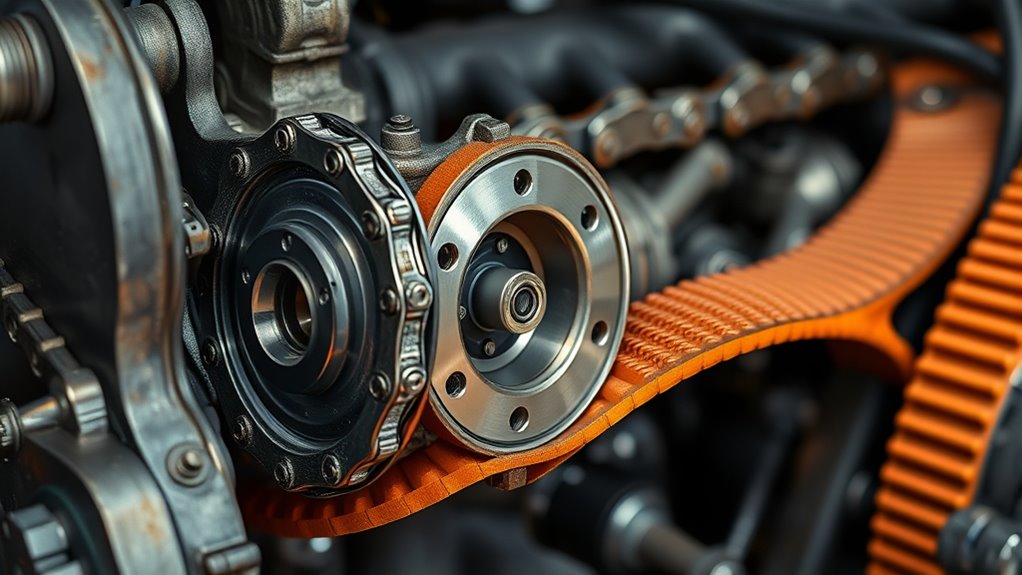
Older 2.2L and 2.4L TDCi Ford Transit engines are equipped with timing chains rather than belts. These chains are designed for durability and can often last well beyond 300,000 miles, with some reaching over 530,000 km. Unlike belts, chains are housed inside metal covers, making visual inspection a key step. Keep in mind:
- Chains generally don’t have a fixed replacement interval, reducing maintenance schedules.
- They are more resistant to failure, but wear over time can still occur.
- Upgraded twin duplex chain kits are available for enhanced longevity and reliability.
- Chains can be inspected through the metal cover to monitor for wear or damage without removing the entire assembly. Additionally, chain wear indicators are sometimes incorporated into the design to help identify when replacement might be necessary. Regular inspection and maintenance can help extend the life of the chain significantly.
Using genuine Ford parts during replacements ensures peak performance. Overall, chains in these engines offer a more robust, low-maintenance solution compared to timing belts.
Maintenance and Replacement Intervals for Wet Belts
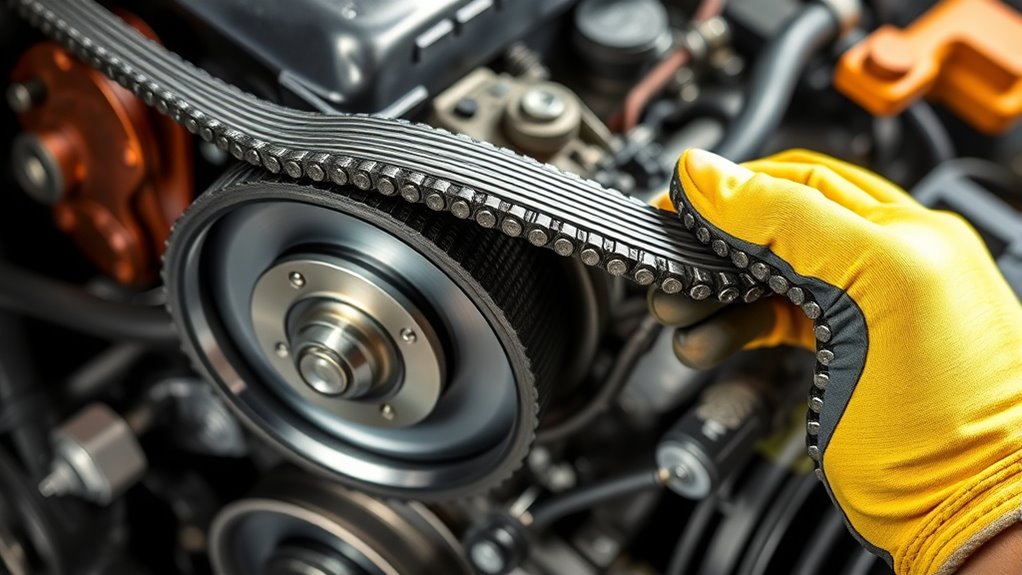
Understanding when to replace your wet belt is vital for avoiding costly engine damage. Ford now recommends changing it every 6 years or 100,000 miles, but many experts suggest doing it even earlier. Keep an eye out for signs of wear, and consider the costs and maintenance factors involved to keep your Transit running smoothly. Ford’s revised guidance reflects the ongoing issues with premature belt failures, underscoring the importance of proactive maintenance. Regular inspections can help detect early signs of deterioration, especially considering the glycolic acid benefits for skin that promote overall engine health. Incorporating sound healing science principles, such as monitoring vibrations and frequencies within engine components, can also contribute to early detection of mechanical issues. Recognizing angel numbers related to divine love can provide additional spiritual reassurance during your vehicle maintenance journey.
Replacement Schedule Recommendations
To guarantee your Ford Transit’s engine runs smoothly and avoid costly repairs, it’s essential to follow recommended timing belt replacement schedules. Ford advises changing the wet timing belt at 100,000 miles or 6–8 years, whichever comes first, with earlier replacement for some models like the 2.0L EcoBlue. For newer engines, Ford recommends replacing the belt every 6 years or 100,000 miles along with tensioners and idler pulleys. Keep in mind:
- Always adhere to the manufacturer’s specified intervals to prevent belt failure.
- Replace related components like tensioners and pulleys during belt service.
- Consider driving conditions—harsh environments and heavy use may require earlier replacements. Understanding engine design and interference engine mechanisms can help prevent severe engine damage.] Regular inspections of belt condition, especially in high-mileage or harsh conditions, can help detect early signs of wear. Following these guidelines helps prevent engine damage, costly repairs, and downtime. Regular maintenance ensures your Transit stays reliable and operational.
Signs of Belt Wear
Since wet timing belts are submerged in oil, detecting wear can be challenging, but paying attention to specific signs helps prevent sudden failures. Listen for rattling, knocking, or ticking noises, which indicate looseness or wear. Difficulty starting the engine or rough running suggests timing issues. Oil leaks around the timing cover may signal seal problems affecting the belt. Visual inspection is tough, but signs like oil contamination, cracks, or fraying hint at deterioration. Use these indicators:
| Symptom | Cause | Action |
|---|---|---|
| Unusual engine noises | Belt slack or damage | Inspect and replace belt |
| Engine misfires | Timing misalignment | Check timing components |
| Poor fuel economy | Belt slipping or wear | Schedule maintenance |
| Engine stalls | Belt failure or slip | Seek immediate repair |
Regularly monitor these signs to avoid costly damage. Understanding the importance of the timing mechanism helps emphasize why early detection and maintenance are crucial to prevent engine failure. Additionally, adhering to the recommended maintenance intervals can significantly extend the lifespan of your engine components.
Being aware of engine timing issues and how to spot them can save you from extensive repairs down the line.
Cost and Maintenance Factors
Regularly replacing the wet timing belt is vital to prevent costly engine damage, especially since these belts operate submerged in oil, which accelerates wear. To guarantee reliability, follow recommended intervals: 1. Ford suggests replacing the belt every 6 years or 100,000 miles (160,000 km). 2. For EcoBlue engines, the full service cost, including related components, is around £1,099 in the UK. 3. Replacing the water pump at the same time saves labor and prevents future failures. Since oil contamination can speed up belt deterioration, maintaining proper oil quality and timely changes are essential. Proper oil changes can significantly extend the life of the timing belt. Early replacement can avoid expensive repairs caused by belt failure. Always rely on specialized service centers for accurate installation and to guarantee the longevity of your engine’s timing system. Being aware of engine maintenance best practices can further help in preventing unexpected failures and ensuring optimal engine performance.
Benefits and Drawbacks of Timing Chains Versus Belts
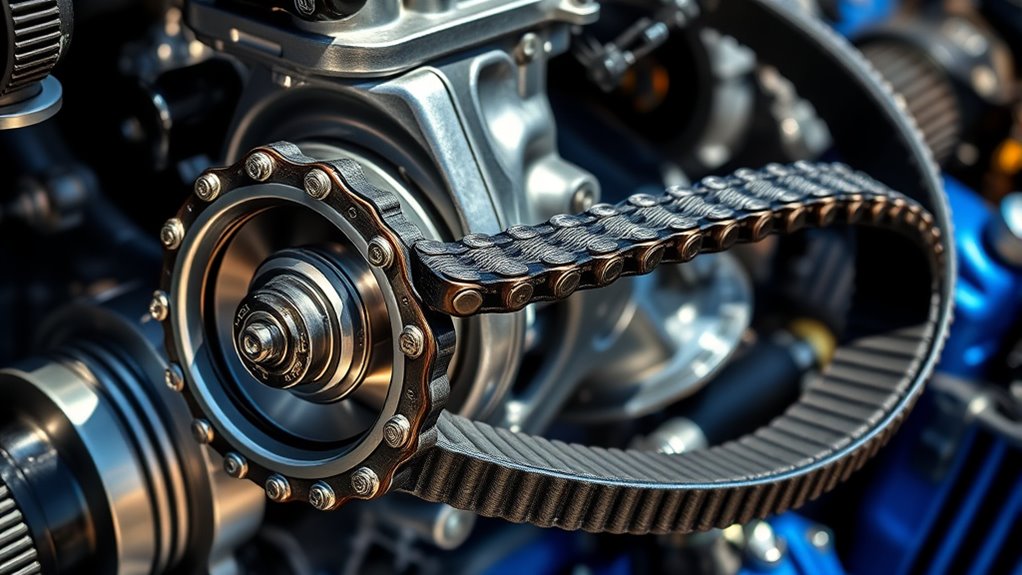
Timing chains and belts each have distinct advantages and disadvantages that can influence your vehicle’s performance and maintenance needs. Chains last longer, often exceeding 200,000 miles, and don’t require scheduled replacement, but they’re heavier and can produce more noise. Belts are quieter and lighter, improving fuel efficiency, but they wear out more quickly, typically around 60,000 to 100,000 miles, and need regular replacement.
| Feature | Timing Chain | Timing Belt |
|---|---|---|
| Durability | Lasts entire engine life | Requires regular replacement |
| Noise | Slight noise, improving with tech | Quiet operation |
| Maintenance | Minimal, check oil levels | Scheduled replacements needed |
| Cost | Higher initial repair costs | Lower initial cost |
| Design Impact | Heavier, impacts engine weight | Lightweight, compact design |
Signs of Timing System Wear or Failure

Worn or failing timing systems often reveal themselves through specific signs that shouldn’t be ignored. First, listen for unusual engine noises like rattling, knocking, or clattering, which indicate slack or wear in the chain or belt. Second, notice performance issues such as poor acceleration, misfires, or engine stalling, caused by timing discrepancies. Third, perform visual inspections for cracks, fraying, or oil contamination on the belt, or signs of elongation and debris in the timing chain. Additionally, warning lights or check engine alerts related to camshaft or crankshaft sensors often point to timing problems. Ignoring these signs can lead to severe engine damage, including valve-piston collisions or engine failure, making early detection essential for avoiding costly repairs. Regular maintenance and timely replacement are crucial because timing components wear out over time regardless of visible damage.
Best Practices for Ensuring Reliable Timing System Performance
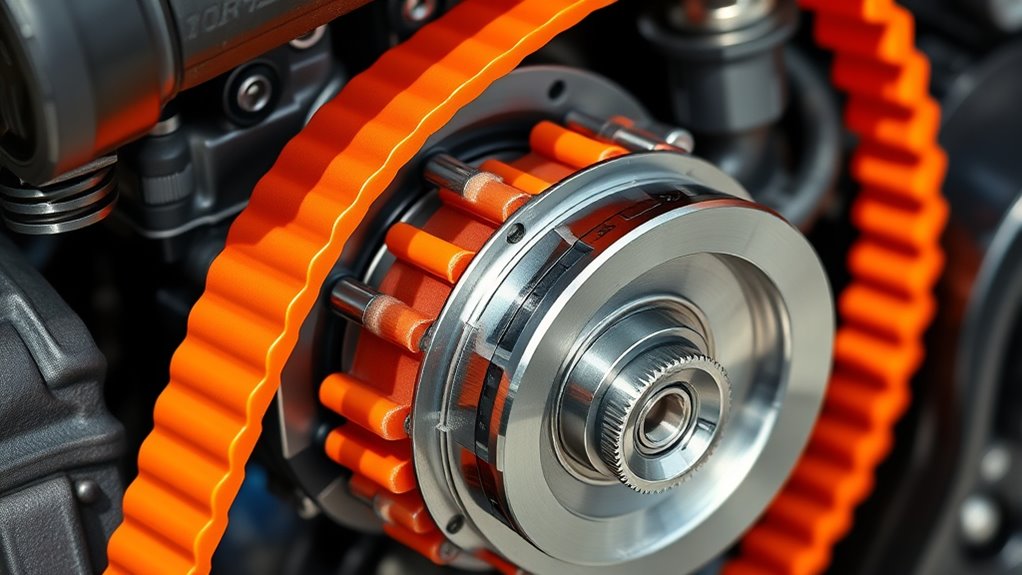
Ensuring your Ford Transit’s timing system performs reliably requires diligent maintenance tailored to its specific components. Regular oil changes with high-quality, manufacturer-approved oils keep chains lubricated and prevent premature wear. Monitoring engine performance helps catch early signs of chain stretch or wet belt degradation. Inspect tensioners, guides, and belt conditions periodically, replacing worn parts before failure. For wet belts, maintain clean oil and address sludge buildup to prevent early deterioration. Adhere to recommended replacement intervals—around 144,000 miles or sooner if needed—and use OEM parts for durability. Keep an eye on oil levels and pressure, as proper lubrication is vital. Implementing these practices minimizes unexpected failures and prolongs your engine’s lifespan.
| Component | Maintenance Action | Recommended Interval |
|---|---|---|
| Timing Chain | Regular oil changes, inspect tensioners | Every 5,000–10,000 miles |
| Wet Belt | Monitor oil quality, replace as needed | Approx. 67,000–144,000 miles |
| General | Check for leaks, maintain oil pressure | Ongoing |
Frequently Asked Questions
How Do I Differentiate Between a Wet Belt and a Chain in My Ford Transit?
To tell if you have a wet belt or a chain in your Ford Transit, look under the timing cover. A wet belt will be made of rubber, often with a shiny or textured surface, and may appear slightly oily but remains rubbery. A chain, on the other hand, consists of metal links, is enclosed in oil within a metal cover, and looks metallic. Listen for noise—chains often rattle, belts stay quiet.
Can a Wet Belt Be Inspected Visually Without Engine Disassembly?
You can’t reliably inspect a wet timing belt visually without engine disassembly. While small inspection ports offer a glimpse, they don’t reveal critical details like cracks or fraying. Oil or coolant on the belt further obscures signs of wear, making a thorough check impossible without removing covers. Relying solely on indirect methods isn’t enough; regular scheduled replacements are the best way to guarantee your belt’s health.
What Are the Risks of Delaying Wet Belt Replacement on Ecoblue Engines?
If you delay replacing the wet belt on EcoBlue engines, you risk catastrophic failure. The belt can disintegrate, causing valve and piston collisions, severe internal damage, and engine seizure. Without warning signs, you might face costly repairs exceeding £10,000 and extended downtime. Regular inspections, timely replacements, and monitoring oil quality help prevent these risks, ensuring your engine stays reliable and avoids sudden, expensive breakdowns.
Are There Any Aftermarket Parts That Extend Timing Belt Replacement Intervals?
You might find aftermarket timing belt kits claiming to extend replacement intervals, but there’s no solid proof they actually do. Many brands promise longer life with better materials or coatings, yet independent data is limited. Relying on these claims can be risky since failures still happen before OEM intervals. To keep your engine safe, stick to Ford’s recommended replacement schedule and maintain proper maintenance practices.
How Does Oil Quality Affect the Lifespan of Wet Timing Belts?
You can considerably extend your wet timing belt’s lifespan by maintaining high oil quality. Good quality oil reduces friction, prevents sludge buildup, and protects belt fibers from chemical damage. Regular oil changes with the right type keep the lubrication ideal, reducing wear and tear. Avoid contaminated or degraded oil, as it accelerates belt deterioration, increases the risk of failure, and can lead to costly engine repairs.
Conclusion
Knowing whether your Ford Transit has a timing belt or chain can save you costly repairs down the line. Did you know that timing belts typically last around 60,000 to 100,000 miles, while chains often go beyond 200,000 miles? Regular maintenance and prompt attention to signs of wear guarantee your engine stays reliable. Stay proactive, follow recommended intervals, and you’ll keep your Transit running smoothly for years to come.
